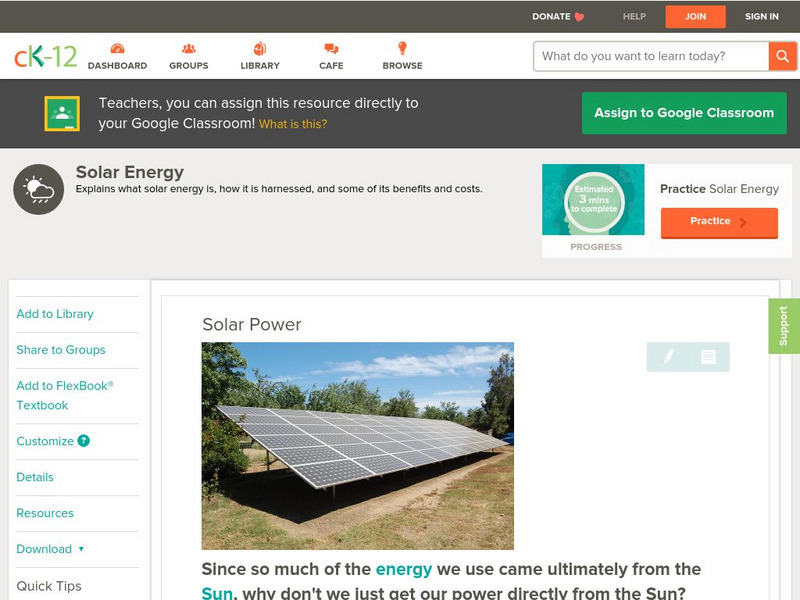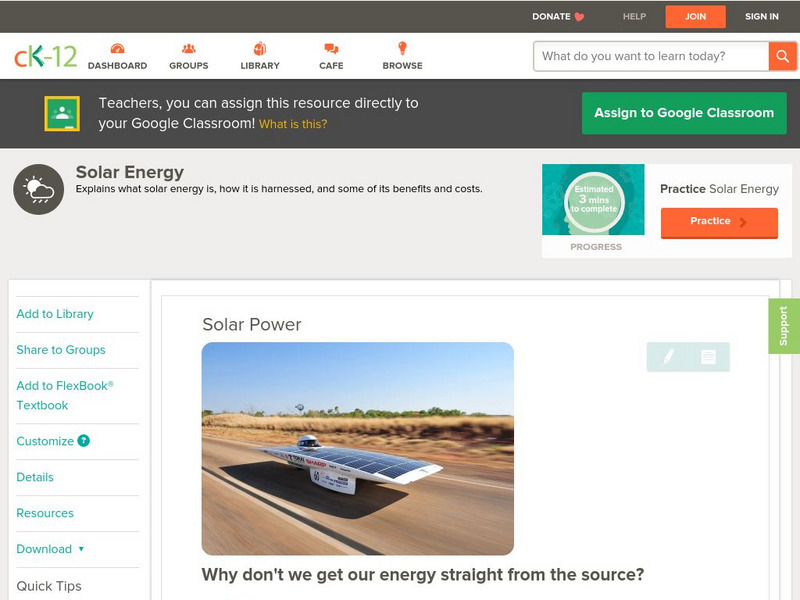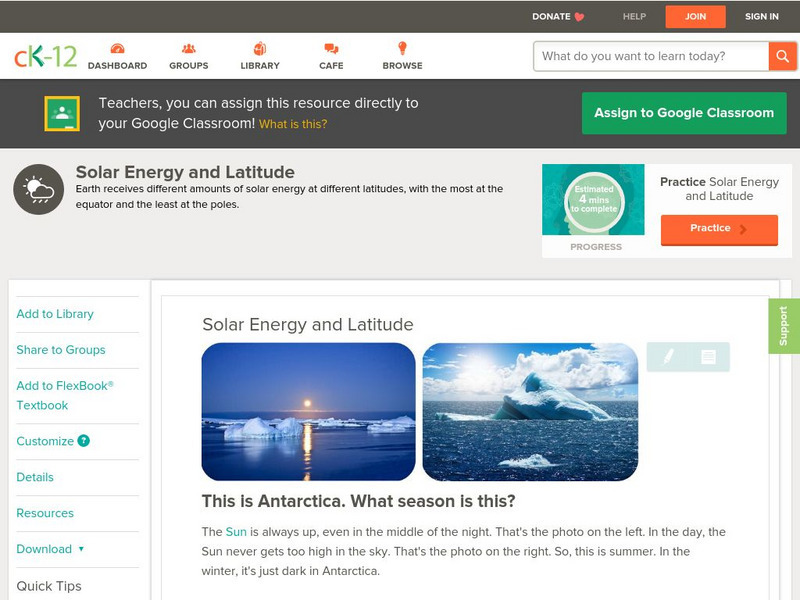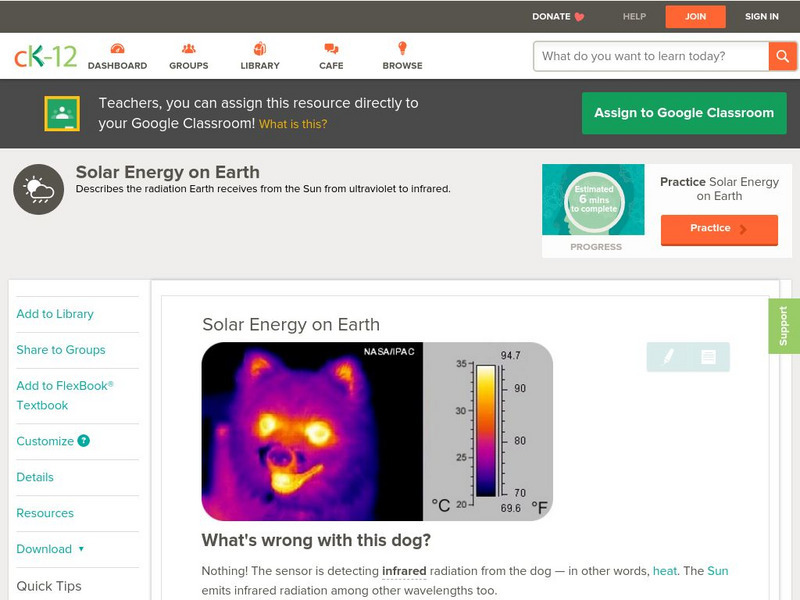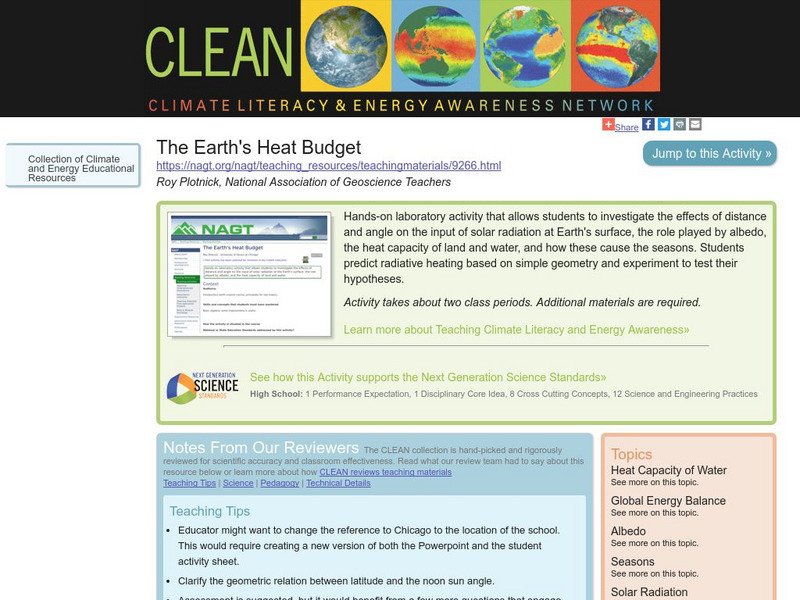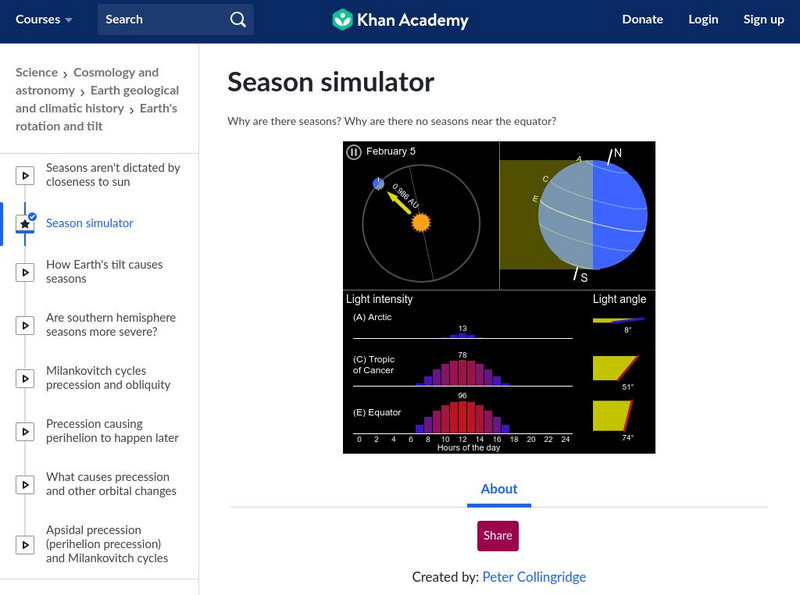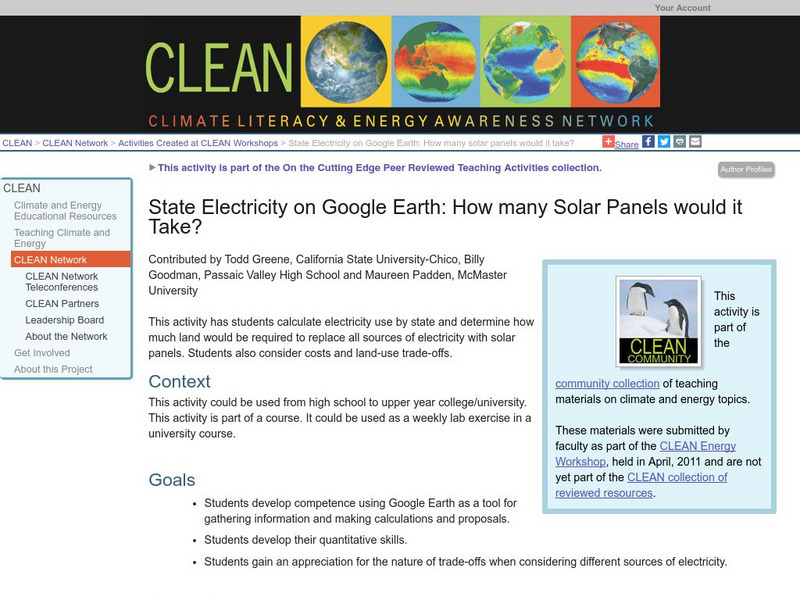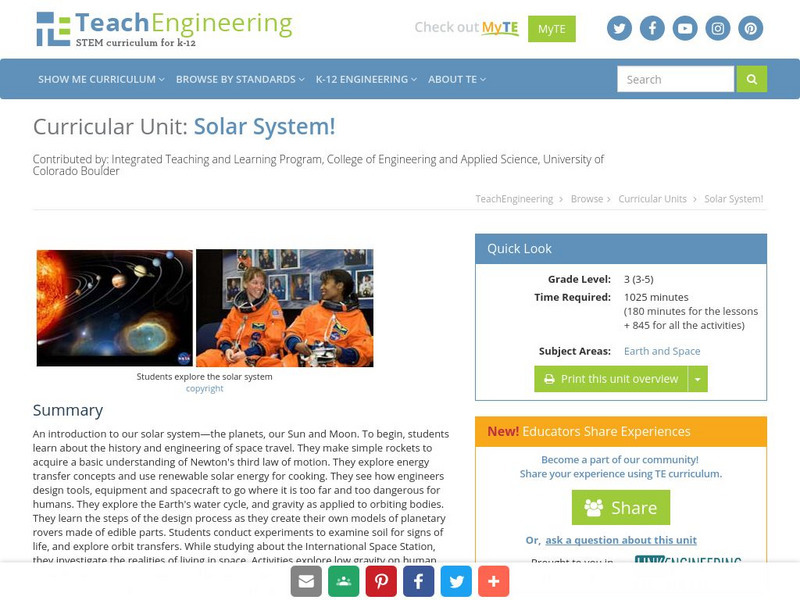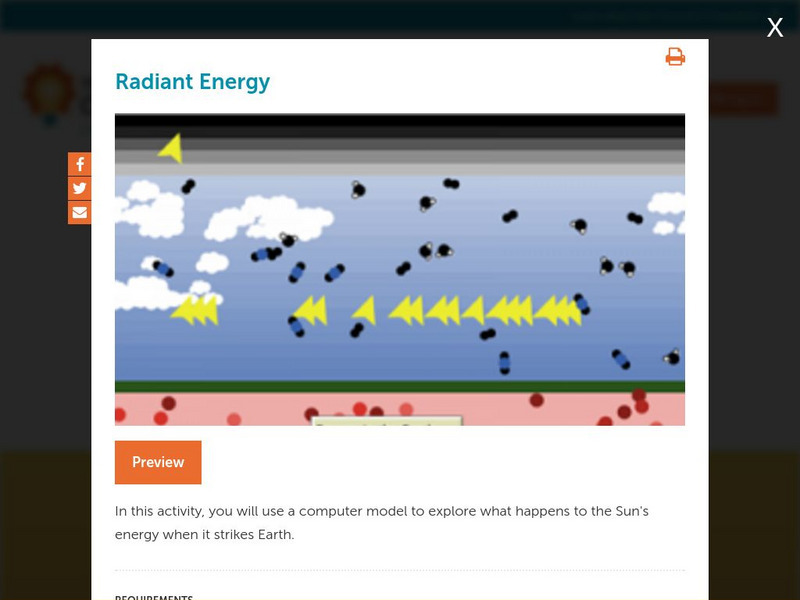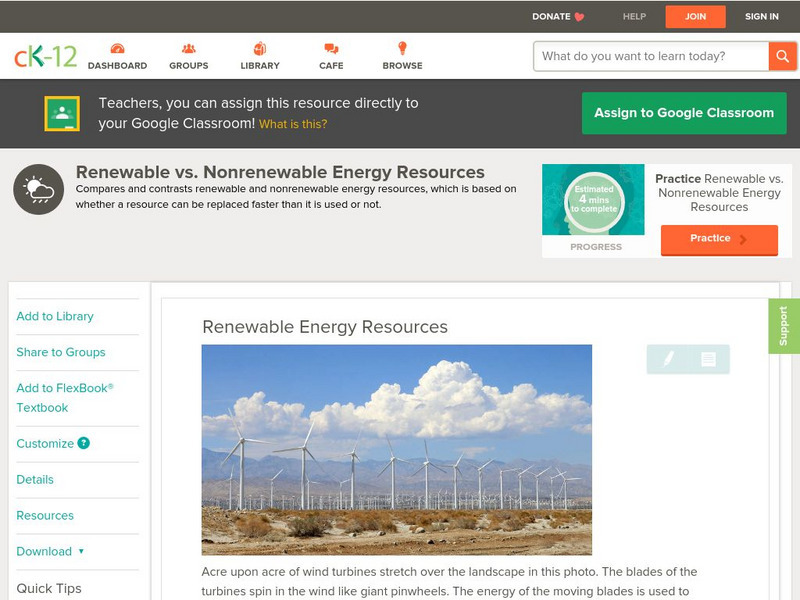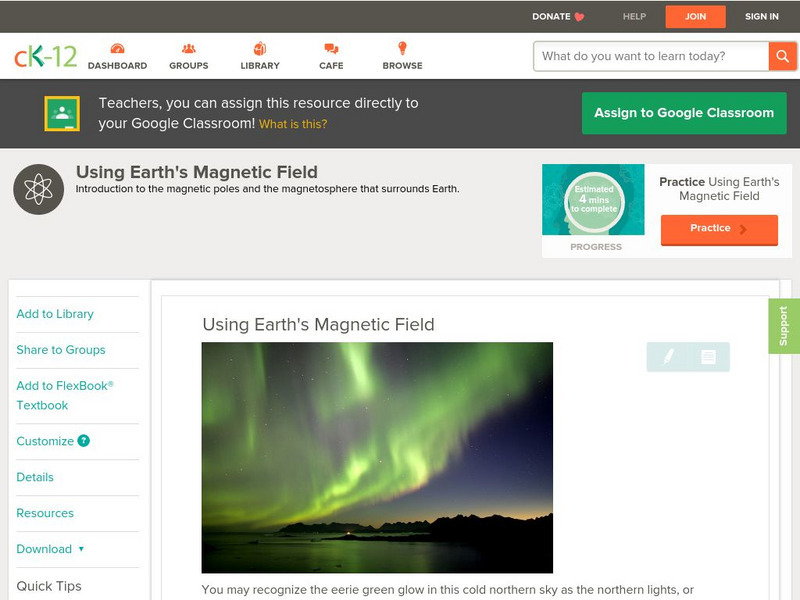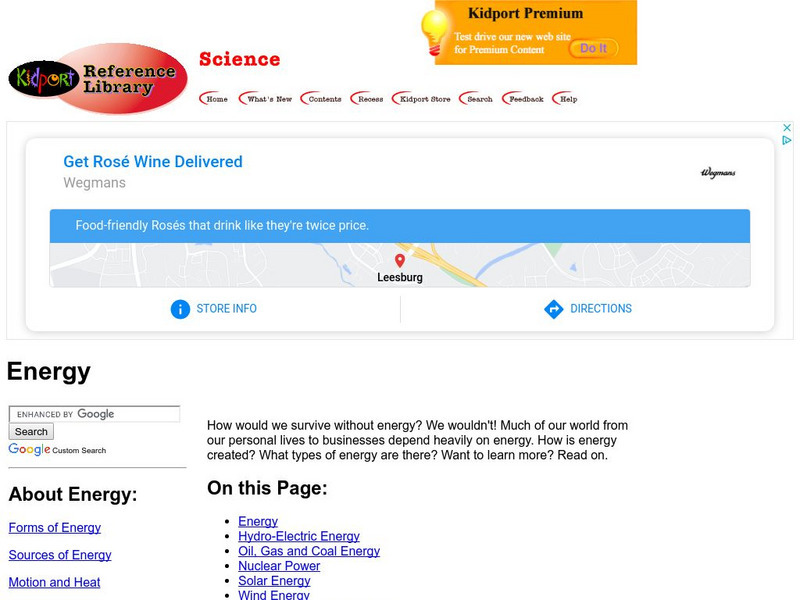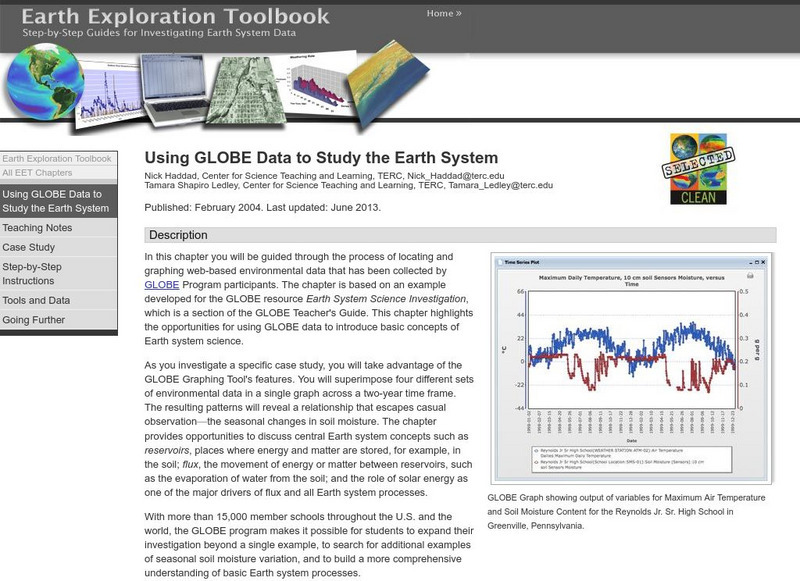TeachEngineering
Teach Engineering: Solar Power
Students learn about solar energy and how to calculate the amount of solar energy available at a given location and time of day on Earth. The importance of determining incoming solar energy for solar devices is discussed.
CK-12 Foundation
Ck 12: Earth Science: Solar Energy on Earth
[Free Registration/Login may be required to access all resource tools.] Describes characteristics of solar energy including the electromagnetic spectrum and movement.
CK-12 Foundation
Ck 12: Earth Science: Solar Power
[Free Registration/Login may be required to access all resource tools.] How solar energy can be used and its consequences.
CK-12 Foundation
Ck 12: Earth Science: Solar Power
[Free Registration/Login may be required to access all resource tools.] How solar energy can be collected and used, and the consequences of it.
CK-12 Foundation
Ck 12: Earth Science: Solar Energy and Latitude
[Free Registration/Login may be required to access all resource tools.] Discusses the relationship between solar energy and latitude.
CK-12 Foundation
Ck 12: Earth Science: Solar Energy on Earth
[Free Registration/Login may be required to access all resource tools.] A breakdown of the types of energy that Earth receives from the sun.
American Geosciences Institute
American Geosciences Institute: Energy
Seven hands-on lessons module where students learn about energy. These inquiry-based explorations investigate where energy resources come from and how they are converted into electricity, how fossil fuels form, the importance of...
Climate Literacy
Clean: The Earth's Heat Budget
Students investigate the effects of distance and angle on the input of solar radiation at the Earth's surface, the role played by albedo, and the heat capacity of land and water.
Science Education Resource Center at Carleton College
Serc: Lab 7: A Year in the Life of the Earth System
An investigation that is part of a series of lab lessons that expose students to Earth Systems through research, data, and visualizations. In this lab, students will observe how the Earth has changed over time to understand the Earth as...
Khan Academy
Khan Academy: Cosmology and Astronomy: Season Simulator
This season simulator takes Earth through an entire year cycle allowing the viewer to observe the tilt of the Earth and the intensity of the sunlight.
Climate Literacy
Clean: State Electricity on Google Earth: How Many Solar Panels Would It Take?
This activity addresses the Energy Awareness Principle by having students calculate electricity use by state, and also determine how much land would be required to replace all sources of electricity with solar panels considering costs...
Science Education Resource Center at Carleton College
Serc: Lab 3: Discovering Local Data
An investigation that is part of a series of lab lessons that expose young scholars to Earth Systems through research, data, and visulazations. This lab specifically has students using a database to gather and graph data to understand...
TeachEngineering
Teach Engineering: Solar System!
An introduction to our solar system: the planets, our Sun and our Moon. Students begin by learning the history and engineering of space travel. They make simple rockets to acquire a basic understanding Newton's third law of motion. They...
Concord Consortium
Concord Consortium: Stem Resources: Radiant Energy Flow
A virtual lab to look at the physical features of Earth that affect the amount of the Sun's energy that hits Earth. Students investigate how solar and infrared radiations enters and leaves the atmosphere with this model. Virtual lab...
Concord Consortium
Concord Consortium: Stem Resources: Solar Oven
Use the sun's energy to cook an egg? Design, build and test a solar oven. Activity gives a procedure to build oven as well as questions to answer. Questions can be saved and graded by instructor.
CK-12 Foundation
Ck 12: Earth Science: Renewable Energy Resources
[Free Registration/Login may be required to access all resource tools.] What renewable energy resources are and examples of renewable energy resources.
CK-12 Foundation
Ck 12: Physical Science: Using Earth's Magnetic Field
[Free Registration/Login may be required to access all resource tools.] The Earth's magnetic field and how it protects life on Earth, and how it is used for navigation.
Science Education Resource Center at Carleton College
Serc: Sea Ice Extension for the Earth as a System Learning Activity
The purpose of this lesson is for students to learn how the Earth's systems interact on a global level. They will examine global environmental data and compare this to data on the polar regions. In the process, they will develop an...
American Museum of Natural History
American Museum of Natural History: O Logy: Journey to Deep Sea Vents
Take a submersible down to the seafloor. As you descend, passing through the ocean's sunlight, twilight, and midnight zones, you can observe how temperature, pressure, and light levels change. When your submersible reaches the seafloor,...
Kidport
Kidport Reference Library: Energy
A simple introduction to energy, offering information on hydro-electric energy, fossil fuels, nuclear power, solar energy, and wind energy.
Climate Literacy
Clean: Introduction to Earth's Climate
This lesson plan is an introduction to Earth's climate and covers key principles regarding Earth's unique climate, atmosphere, and regional and temporal climate differences. Young scholars will gain an understanding of how the weather...
NASA
Nasa: Effect of the Sun's Energy on the Ocean and Atmosphere
A project based lesson where students' mission is to conduct a series of tasks that enable them to audit Earth's energy budget and help answer a number of science questions.
Science Education Resource Center at Carleton College
Serc: Using Globe Data to Study the Earth System
This lesson guides students through the process of locating and graphing web-based environmental data that has been collected by GLOBE Program participants. The lesson provides opportunities for using GLOBE data to introduce basic...
CK-12 Foundation
Ck 12: Earth Science: Global Wind Belts
[Free Registration/Login may be required to access all resource tools.] Describes how regional differences in solar radiation create global wind belts.


